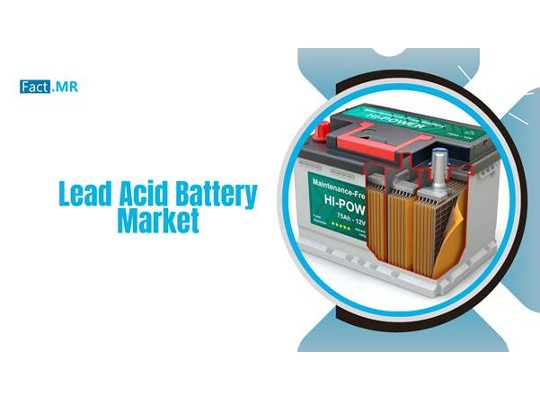As of 2023, worldwide shipments of lead acid batteries account for a market valuation of US$ 57.1 billion and are estimated to reach US$ 96.5 billion by the end of 2033.
The global lead acid battery market, a cornerstone of the energy storage sector, has demonstrated significant resilience and adaptability amid evolving energy demands and technological advancements. Lead acid batteries, known for their reliability and cost-effectiveness, have maintained a strong presence in various applications ranging from automotive to industrial and backup power solutions.
Market Dynamics and Growth Drivers
The lead acid battery market is driven by several key factors. Firstly, the robust demand from the automotive sector, particularly for starting, lighting, and ignition (SLI) applications, continues to be a primary growth driver. Despite the advent of alternative battery technologies, lead acid batteries remain the preferred choice for automotive applications due to their low cost, high reliability, and established recycling infrastructure. The increasing production of vehicles, especially in emerging economies, further bolsters this demand.
Another significant driver is the growing need for uninterruptible power supply (UPS) systems across various industries, including healthcare, telecommunications, and data centers. The reliability and cost-effectiveness of lead acid batteries make them an ideal choice for UPS systems, ensuring continuity of operations during power outages. Additionally, the rising adoption of renewable energy systems, which require efficient and reliable energy storage solutions, has contributed to the market’s growth. Lead acid batteries are widely used in solar and wind energy storage applications, providing a stable and reliable source of power.
Technological Advancements and Innovations
While the basic technology of lead acid batteries has remained largely unchanged for decades, ongoing research and development efforts have led to significant improvements in their performance and efficiency. Innovations such as the development of advanced lead carbon batteries, which combine the benefits of lead acid and supercapacitor technologies, have enhanced the energy density, cycle life, and overall performance of lead acid batteries. These advancements have opened new opportunities for their use in various applications, including hybrid and electric vehicles, and grid energy storage.
Moreover, improvements in manufacturing processes and materials have resulted in more durable and efficient lead acid batteries. Enhanced grid designs, better separators, and the use of advanced alloys have contributed to longer battery life and improved performance. These technological advancements are critical in maintaining the competitiveness of lead acid batteries in the face of increasing competition from other battery technologies, such as lithium-ion.
Regional Market Insights
The lead acid battery market exhibits significant regional variations, driven by differences in industrialization, vehicle production, and energy storage needs. Asia-Pacific, particularly China and India, dominates the market, accounting for a substantial share of global production and consumption. The region’s rapid industrialization, urbanization, and increasing demand for automotive and renewable energy storage solutions are key factors driving market growth. China’s aggressive push towards electric vehicles and renewable energy adoption has further accelerated the demand for lead acid batteries.
North America and Europe also represent significant markets for lead acid batteries, driven by the strong automotive industry and the increasing need for backup power solutions. In these regions, stringent environmental regulations and growing awareness about battery recycling have fostered the development of more sustainable lead acid battery technologies. Additionally, the presence of major automotive manufacturers and technological advancements in battery manufacturing contribute to the market’s growth in these regions.
Environmental and Regulatory Landscape
The lead acid battery market operates within a complex regulatory framework, particularly concerning environmental impact and recycling. Lead is a toxic substance, and improper disposal of lead acid batteries can result in significant environmental harm. Consequently, stringent regulations regarding the production, disposal, and recycling of lead acid batteries have been implemented in many regions. These regulations aim to minimize environmental impact and promote the safe handling and recycling of lead acid batteries.
The recycling of lead acid batteries is a well-established and highly efficient process, with over 95% of the materials, including lead and plastic, being recoverable. This high recyclability rate makes lead acid batteries one of the most environmentally friendly energy storage solutions available. The recycling industry not only helps in reducing the environmental footprint but also ensures a steady supply of lead for battery production, thereby reducing reliance on primary lead resources.
Future Prospects and Challenges
Despite the growth opportunities, the lead acid battery market faces several challenges. The increasing competition from lithium-ion and other advanced battery technologies, which offer higher energy densities and longer cycle lives, poses a significant threat. Additionally, the environmental concerns associated with lead and the stringent regulations on lead handling and disposal could impact market growth.
However, the continued advancements in lead acid battery technology, along with the development of more sustainable and efficient recycling processes, are expected to mitigate these challenges. The market’s future growth will likely be driven by the expanding applications of lead acid batteries in renewable energy storage, automotive, and industrial sectors, coupled with ongoing efforts to improve their performance and sustainability.













